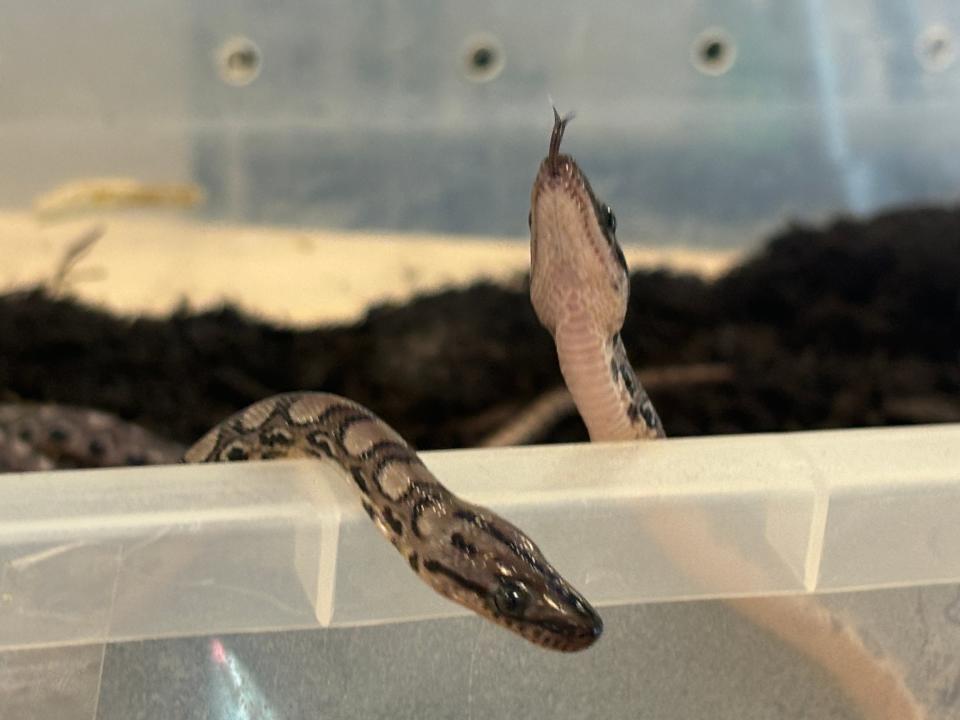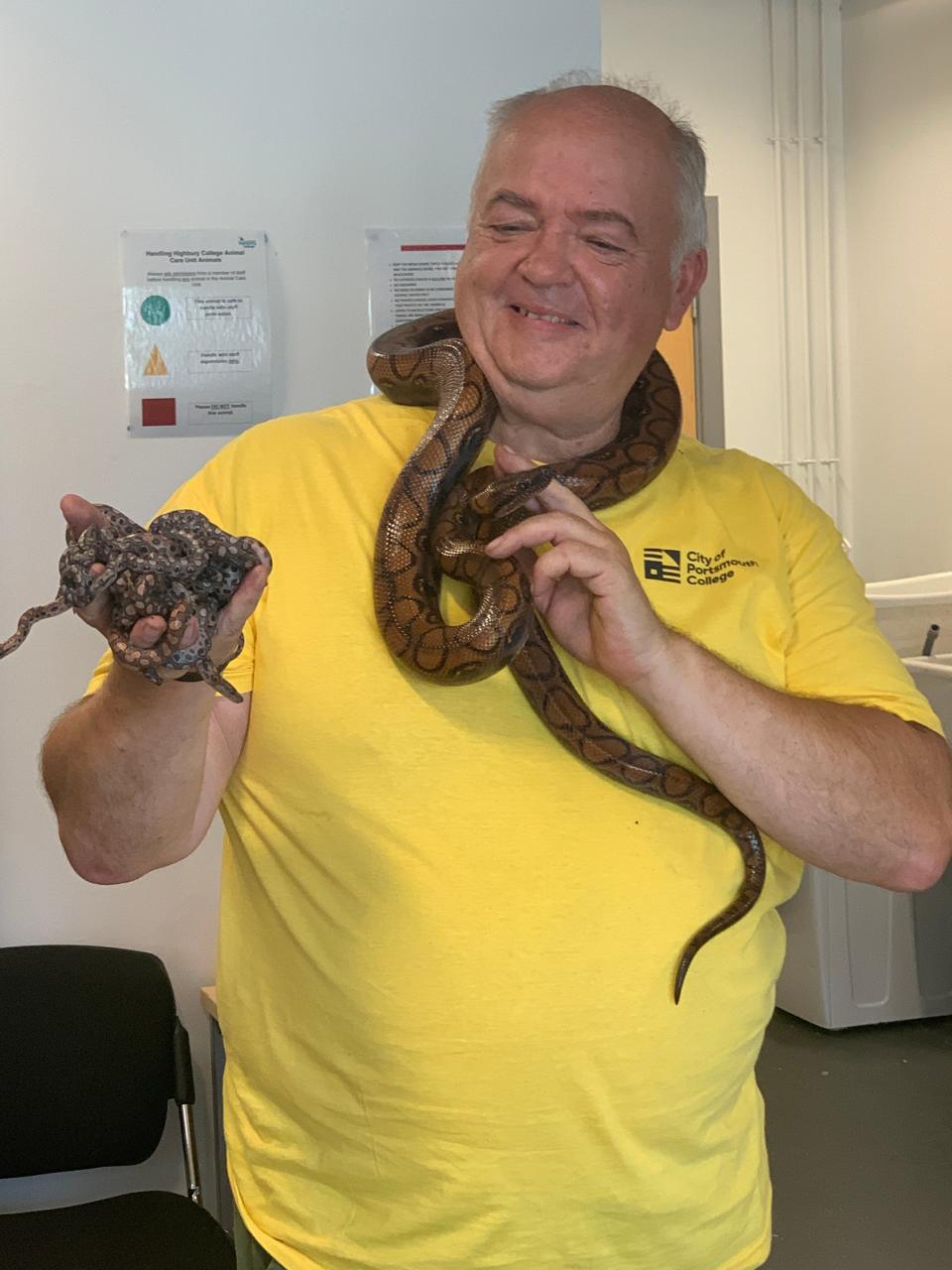Students and staff at a college in England were shocked to find that a snake – one they thought was a boy – had given birth to 14 snakes on Friday.
But perhaps the most shocking fact of the matter is that the snake hadn’t been in contact with other snakes in over a decade, said Pete Quinlan, an animal care technician at City of Portsmouth College.
The birth is a rare phenomenon called parthenogenesis. It’s a natural form of asexual reproduction where embryos develop without fertilization, the school said.
“I’ve never ever seen this before,” said Quinlan, who added he’s been involved in reptile clubs and keeping snakes for 50 years. “I’ve bred lots of different types of snakes, lots of different species and I’ve just never heard of this. This is just so unusual and so rare.”
Quinlan was off for the day when a student checked on the snake, a 13-year-old six-foot Brazilian rainbow boa named Ronaldo. The student found Ronaldo with 14 babies in her vivarium, he told USA TODAY Wednesday morning.
“I received a phone call from a member of staff asking me why I put lots of small snakes in with Ronaldo,” Quinlan said, adding that he thought someone must’ve made a mistake. “I wouldn’t have done that.”
Quinlan went to check the situation and that’s when he realized Ronaldo isn’t a boy after all. Not only that, but the snake hadn’t had contact with other snakes in quite some time, so it was shocking that she became pregnant.
“I had to go away and talk to some friends of mine that were also animal experts and did a lot of research until we eventually found out that it was this rare, rare phenomenon,” said Quinlan, who has been breeding snakes for 50 years.
Quinlan previously said on the school’s website that the snake had been looking “slightly fatter than usual” but they assumed it had been eating a lot. Never could they imagine she was about to become a mom of 14.
He said 14 babies is average for Brazilian rainbow boas. They typically birth about 12 to 15 babies but they can have up to about 25.
Surprise Rainbow Boa snakes are being monitored
Quinlan said students and staff are monitoring the 14 snakes’ progress. The school will likely keep two or three of them and then the rest will be rehomed.
The snakes are so fresh they haven’t even had their first meal yet, Quinlan said. They won’t eat until they’re done shedding. After that, they’ll be ready to eat very small, frozen baby mice, Quinlan said.
“By this time next week, they all would have probably shed and then they’ll have their first meal,” Quinlan said Wednesday morning. “We’re going to go to make sure that they’re all feeding OK and they’re all healthy.”
For now, the newborn snakes are living off egg yolk and nutrients from their mother.
“They’ve still got plenty of nutrients in them to last them up to the next week after their first shed,” Quinlan said.
He’s looking forward to seeing his students raise the babies since they haven’t had that experience before.

Ronaldo went undetected as a male for nine years
Ronaldo used to be Quinlan’s pet. He first rescued her nine years ago from an animal charity.
She was already an adult at the time and the charity had deemed her a male, Quinlan said, adding that determining a snake’s sex can be a little more difficult when they’re adults. He had no plans to breed Ronaldo so he didn’t take any further steps to determine her sex.
“She was only ever going to be a pet snake,” Quinlan said. “I wasn’t really interested in whether she was male or female at that time.”
When Quinlan got a job as an animal care technician at City of Portsmouth College three years ago, he donated Ronaldo and other snakes to the institution, which was starting an animal care program and needed to get animals for students to care for immediately.
The expert has been interested in reptiles since he was a child, he told USA TODAY.
The school has a collection of lizards, snakes and amphibians students are learning to care for. Some of their students want to work with reptiles in pet shops or reptile shops, while others want to work at zoos, vets and other institutions.
What led this expert to 50 years of reptile breeding?
Quinlan said he has been interested in reptiles since childhood. He moved from the city to the countryside and was fascinated with animals.
“I remember seeing my first newt in a pond and thinking it was a crocodile,” he said. “I was just absolutely fascinated with reptiles and amphibians. Every day, as soon as I finished school, I was out there in the fields and the woodlands trying to find animals, studying them.”

As he grew older, he learned about different snakes, including the corn snake, known for its red or orange color. He was “blown away” and had never seen anything of the sort, and eventually he learned about color mutations and decided to breed snakes himself.
Finding out that Ronaldo is a girl and a new mom is exciting for City of Portsmouth College, Quinlan said.
“This is so unusual, so rare,” he said. “The students are so excited about it.”
Saleen Martin is a reporter on USA TODAY’s NOW team. She is from Norfolk, Virginia – the 757. Follow her on Twitter at @SaleenMartin or email her at sdmartin@usatoday.com.
This article originally appeared on USA TODAY: Rainbow boa snake gives birth to 14 babies in ‘rare phenomenon’
Signup bonus from





